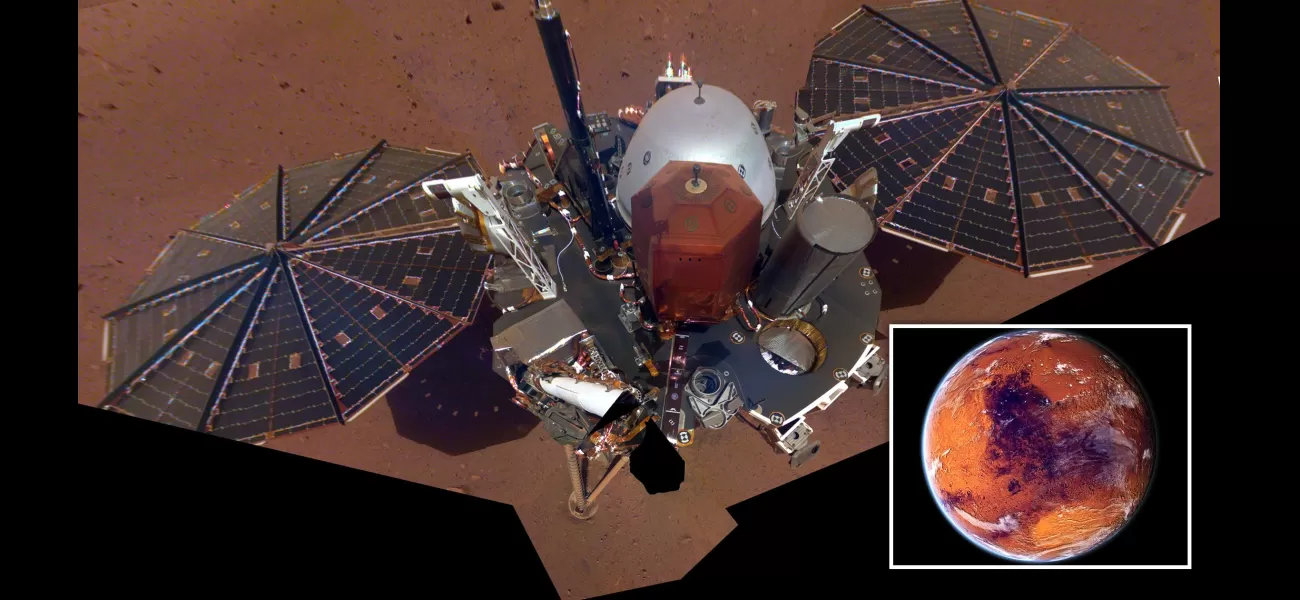Water that could potentially support life has been discovered deep below the surface of Mars, in its oceans 12 miles deep.
Possible paraphrase: Study finds signs of water on Mars that could support life deep underground.
August 12th 2024.

Recent research has revealed that water may potentially exist on the planet Mars, specifically deep beneath the surface. According to the data collected by NASA's Insight lander, there are indications of deep, porous rocks that could potentially be filled with large bodies of liquid water, potentially covering the entire red planet to a depth of one mile. However, this underground reservoir is located at a depth of 12 miles, making it difficult for current technology to access and sustain any future Martian colony.
It is believed that the oceans on Mars disappeared more than three billion years ago, leaving behind a dry surface. The American geophysicists involved in this research have concluded that this underground reservoir may not be of much use to future colonists, as it is located in small cracks and pores within the Martian crust. Even drilling a hole just one mile deep poses a significant challenge, even on Earth.
The results of this study, published in the journal Proceedings of the National Academy of Sciences, do provide a potential location to search for life on Mars if the reservoir can be accessed. Furthermore, it sheds light on the geological history of the planet. According to Dr. Vashan Wright, from the University of California San Diego's Scripps Institution of Oceanography, understanding the water cycle on Mars is crucial in understanding its evolution and current state.
The researchers used a mathematical model of rock physics, similar to ones used on Earth to map underground water sources and oil fields, to analyze the seismic data from Insight. They concluded that the data is best explained by a deep layer of fractured igneous rock that is saturated with liquid water. This is significant because igneous rocks are formed from hot magma, indicating that the water may have once been on the planet's surface.
Co-author of the study, Professor Michael Manga from the University of California, Berkeley, suggests that the presence of a large reservoir of liquid water can provide insight into Mars' past climate and its potential for sustaining life. He states that water is an essential component for life as we know it and that the underground reservoir may potentially be a habitable environment. On Earth, deep mines and the ocean floor are known to host life, and the same may be true for Mars.
There is evidence to suggest that Mars once had flowing water on its surface, such as river channels, deltas, and lake deposits. However, this wet period ended over three billion years ago when the planet lost its atmosphere. Planetary scientists have been sending probes and landers to Mars to investigate what happened to the water and whether life exists or used to exist on the planet. The new findings indicate that a significant amount of water may have filtered down into the crust, rather than escaping into space.
The Insight lander, which was sent by NASA to Mars in 2018, collected a wealth of information about the planet's crust, mantle, core, and atmosphere before the mission ended in 2022. According to Prof. Manga, the mission exceeded expectations and provided valuable data on the thickness of the crust, depth of the core, and even the temperature within the mantle. If the crust beneath the Insight lander is similar throughout Mars, it is likely that there is more water in the mid-crust zone than previously believed. However, further research is needed to confirm this and investigate whether these underground water sources could have once filled ancient Martian oceans.
It is believed that the oceans on Mars disappeared more than three billion years ago, leaving behind a dry surface. The American geophysicists involved in this research have concluded that this underground reservoir may not be of much use to future colonists, as it is located in small cracks and pores within the Martian crust. Even drilling a hole just one mile deep poses a significant challenge, even on Earth.
The results of this study, published in the journal Proceedings of the National Academy of Sciences, do provide a potential location to search for life on Mars if the reservoir can be accessed. Furthermore, it sheds light on the geological history of the planet. According to Dr. Vashan Wright, from the University of California San Diego's Scripps Institution of Oceanography, understanding the water cycle on Mars is crucial in understanding its evolution and current state.
The researchers used a mathematical model of rock physics, similar to ones used on Earth to map underground water sources and oil fields, to analyze the seismic data from Insight. They concluded that the data is best explained by a deep layer of fractured igneous rock that is saturated with liquid water. This is significant because igneous rocks are formed from hot magma, indicating that the water may have once been on the planet's surface.
Co-author of the study, Professor Michael Manga from the University of California, Berkeley, suggests that the presence of a large reservoir of liquid water can provide insight into Mars' past climate and its potential for sustaining life. He states that water is an essential component for life as we know it and that the underground reservoir may potentially be a habitable environment. On Earth, deep mines and the ocean floor are known to host life, and the same may be true for Mars.
There is evidence to suggest that Mars once had flowing water on its surface, such as river channels, deltas, and lake deposits. However, this wet period ended over three billion years ago when the planet lost its atmosphere. Planetary scientists have been sending probes and landers to Mars to investigate what happened to the water and whether life exists or used to exist on the planet. The new findings indicate that a significant amount of water may have filtered down into the crust, rather than escaping into space.
The Insight lander, which was sent by NASA to Mars in 2018, collected a wealth of information about the planet's crust, mantle, core, and atmosphere before the mission ended in 2022. According to Prof. Manga, the mission exceeded expectations and provided valuable data on the thickness of the crust, depth of the core, and even the temperature within the mantle. If the crust beneath the Insight lander is similar throughout Mars, it is likely that there is more water in the mid-crust zone than previously believed. However, further research is needed to confirm this and investigate whether these underground water sources could have once filled ancient Martian oceans.
[This article has been trending online recently and has been generated with AI. Your feed is customized.]
[Generative AI is experimental.]
0
0
Submit Comment





